High-Throughput Optimal Design of Spacers Using Triply Periodic Minimal Surfaces in BWRO
Abstract
:1. Introduction
2. Design of TPMS Spacers
Porosity and Hydraulic Diameter
3. Numerical Method
3.1. Modeling and Numerical Simulations of Spacer-Filled Channels in Millimeter Scale
3.1.1. Governing Equations
3.1.2. Boundary Conditions
3.1.3. Selection of Computational Domain and Mesh Independence Test
3.2. Establishment and Solution of Meter-Scale RO System Model
4. Results and Discussion
4.1. RO System-Level Performance
4.2. Local Flow and Mass-Transfer Characteristics
4.2.1. Hydrodynamics and Pressure Drop
4.2.2. Mass Transfer and Concentration Polarization
4.3. Structural Parameters Analysis with a High-throughput Approach
5. Conclusions
Author Contributions
Funding
Institutional Review Board Statement
Informed Consent Statement
Data Availability Statement
Acknowledgments
Conflicts of Interest
References
- Cohen, Y.; Semiat, R.; Rahardianto, A. A perspective on reverse osmosis water desalination: Quest for sustainability. AIChE J. 2017, 63, 1771–1784. [Google Scholar] [CrossRef]
- Oki, T.; Kanae, S. Global Hydrological Cycles and World Water Resources. Science 2006, 313, 1068–1072. [Google Scholar] [CrossRef] [PubMed] [Green Version]
- Song, J.; Li, T.; Wright-Contreras, L.; Law, A.W.K. A review of the current status of small-scale seawater reverse osmosis desalination. Water Int. 2017, 42, 618–631. [Google Scholar] [CrossRef]
- Shenvi, S.S.; Isloor, A.M.; Ismail, A. A review on RO membrane technology: Developments and challenges. Desalination 2015, 368, 10–26. [Google Scholar] [CrossRef]
- Qasim, M.; Badrelzaman, M.; Darwish, N.N.; Darwish, N.A.; Hilal, N. Reverse osmosis desalination: A state-of-the-art review. Desalination 2019, 459, 59–104. [Google Scholar] [CrossRef] [Green Version]
- Uppu, A.; Chaudhuri, A.; Das, S.P. Numerical modeling of particulate fouling and cake-enhanced concentration polarization in roto-dynamic reverse osmosis filtration systems. Desalination 2019, 468, 114053. [Google Scholar] [CrossRef]
- Jasiuk, I.; Abueidda, D.W.; Kozuch, C.; Pang, S.; Su, F.Y.; McKittrick, J. An Overview on Additive Manufacturing of Polymers. JOM 2018, 70, 275–283. [Google Scholar] [CrossRef]
- Lee, J.-Y.; Tan, W.S.; An, Y.; Chua, C.K.; Tang, C.Y.; Fane, A.G.; Chong, T.H. The potential to enhance membrane module design with 3D printing technology. J. Membr. Sci. 2016, 499, 480–490. [Google Scholar] [CrossRef]
- Haidari, A.H.; Heijman, S.G.J.; van der Meer, W.G.J. Optimal design of spacers in reverse osmosis. Sep. Purif. Technol. 2018, 192, 441–456. [Google Scholar] [CrossRef]
- Lin, W.-C.; Shao, R.-P.; Wang, X.-M.; Huang, X. Impacts of non-uniform filament feed spacers characteristics on the hydraulic and anti-fouling performances in the spacer-filled membrane channels: Experiment and numerical simulation. Water Res. 2020, 185, 116251. [Google Scholar] [CrossRef]
- Park, S.; Dal Jeong, Y.; Lee, J.H.; Kim, J.; Jeong, K.; Cho, K.H. 3D printed honeycomb-shaped feed channel spacer for membrane fouling mitigation in nanofiltration. J. Membr. Sci. 2020, 620, 118665. [Google Scholar] [CrossRef]
- Koutsou, C.P.; Karabelas, A.J. A novel retentate spacer geometry for improved spiral wound membrane (SWM) module performance. J. Membr. Sci. 2015, 488, 129–142. [Google Scholar] [CrossRef]
- Su, X.; Li, W.; Palazzolo, A.; Ahmed, S. Concentration polarization and permeate flux variation in a vibration enhanced reverse osmosis membrane module. Desalination 2018, 433, 75–88. [Google Scholar] [CrossRef]
- Liang, Y.Y.; Weihs, G.A.F.; Wiley, D.E. Comparison of oscillating flow and slip velocity mass transfer enhancement in spacer-filled membrane channels: CFD analysis and validation. J. Membr. Sci. 2020, 593, 117433. [Google Scholar] [CrossRef]
- Taherinejad, M.; Afrouzan, A.; Derakhshan, S. CFD Investigation of Near-Membrane Slippery Condition Effects on Water/Salt Transport in a Reverse Osmosis Feed Channel. Arab. J. Sci. Eng. 2021, 46, 6673–6685. [Google Scholar] [CrossRef]
- Yoo, D.-J. Advanced porous scaffold design using multi-void triply periodic minimal surface models with high surface area to volume ratios. Int. J. Precis. Eng. Manuf. 2014, 15, 1657–1666. [Google Scholar] [CrossRef]
- Yinzheng, Z. Numerical Analysis On Fluid-solid Coupling Cooling Of Minimal Surface Lattice Structure. J. Phys. Conf. Ser. 2019, 1187, 032070. [Google Scholar] [CrossRef]
- Pires, T.; Santos, J.; Ruben, R.B.; Gouveia, B.P.; Castro, A.P.; Fernandes, P.R. Numerical-experimental analysis of the permeability-porosity relationship in triply periodic minimal surfaces scaffolds. J. Biomech. 2021, 117, 110263. [Google Scholar] [CrossRef]
- Coimbra, J.C.; Martins, M.A.; Oliveira, P.S.; Minim, L.A. The potential use of a gyroid structure to represent monolithic matrices for bioseparation purposes: Fluid dynamics and mass transfer analysis via CFD. Sep. Purif. Technol. 2010, 254, 117594. [Google Scholar] [CrossRef]
- Sreedhar, N.; Thomas, N.; Al-Ketan, O.; Rowshan, R.; Hernandez, H.; Abu Al-Rub, R.K.; Arafat, H. 3D printed feed spacers based on triply periodic minimal surfaces for flux enhancement and biofouling mitigation in RO and UF. Desalination 2018, 425, 12–21. [Google Scholar] [CrossRef]
- Michielsen, K.; Kole, J.S. Photonic band gaps in materials with triply periodic surfaces and related tubular structures. Phys. Rev. B 2003, 68, 115107. [Google Scholar] [CrossRef] [Green Version]
- Sreedhar, N.; Thomas, N.; Al-Ketan, O.; Rowshan, R.; Hernandez, H.H.; Al-Rub, R.K.A.; Arafat, H.A. Mass transfer analysis of ultrafiltration using spacers based on triply periodic minimal surfaces: Effects of spacer design, directionality and voidage. J. Membr. Sci. 2018, 561, 89–98. [Google Scholar] [CrossRef]
- Shi, X.; Liao, W.; Li, P.; Zhang, C.; Liu, T.; Wang, C.; Wu, J. Comparison of Compression Performance and Energy Absorption of Lattice Structures Fabricated by Selective Laser Melting. Adv. Eng. Mater. 2020, 22, 2000453. [Google Scholar] [CrossRef]
- Weyhaupt, A. Deformations of the gyroid and lidinoid minimal surfaces. Pac. J. Math. 2008, 235, 137–171. [Google Scholar] [CrossRef]
- Bucs, S.S.; Radu, A.I.; Lavric, V.; Vrouwenvelder, J.S.; Picioreanu, C. Effect of different commercial feed spacers on biofouling of reverse osmosis membrane systems: A numerical study. Desalination 2014, 343, 26–37. [Google Scholar] [CrossRef]
- Al-Ketan, O.; Abu Al-Rub, R.K.; Rowshan, R. Mechanical Properties of a New Type of Architected Interpenetrating Phase Composite Materials. Adv. Mater. Technol. 2017, 2, 1600235. [Google Scholar] [CrossRef]
- Suwarno, S.R.; Chen, X.; Chong, T.H.; Puspitasari, V.; McDougald, D.; Cohen, Y.; Rice, S.; Fane, A. The impact of flux and spacers on biofilm development on reverse osmosis membranes. J. Membr. Sci. 2012, 405–406, 219–232. [Google Scholar] [CrossRef]
- Al-Ketan, O.; Al-Rub, R.K. MSLattice: A free software for generating uniform and graded lattices based on triply periodic minimal surfaces. Mat. Des. Process Commun. 2020, 3, e205. [Google Scholar] [CrossRef]
- Schock, G.; Miquel, A. Mass transfer and pressure loss in spiral wound modules. Desalination 1987, 64, 339–352. [Google Scholar] [CrossRef]
- Da Costa, A.R.; Fane, A.G.; Wiley, D.E. Spacer characterization and pressure drop modelling in spacer-filled channels for ultrafiltration. J. Membr. Sci. 1994, 87, 79–98. [Google Scholar] [CrossRef]
- Li, M.; Bui, T.; Chao, S. Three-dimensional CFD analysis of hydrodynamics and concentration polarization in an industrial RO feed channel. Desalination 2016, 397, 194–204. [Google Scholar] [CrossRef]
- Luo, J.; Li, M.; Heng, Y. A hybrid modeling approach for optimal design of non-woven membrane channels in brackish water reverse osmosis process with high-throughput computation. Desalination 2020, 489, 114463. [Google Scholar] [CrossRef]

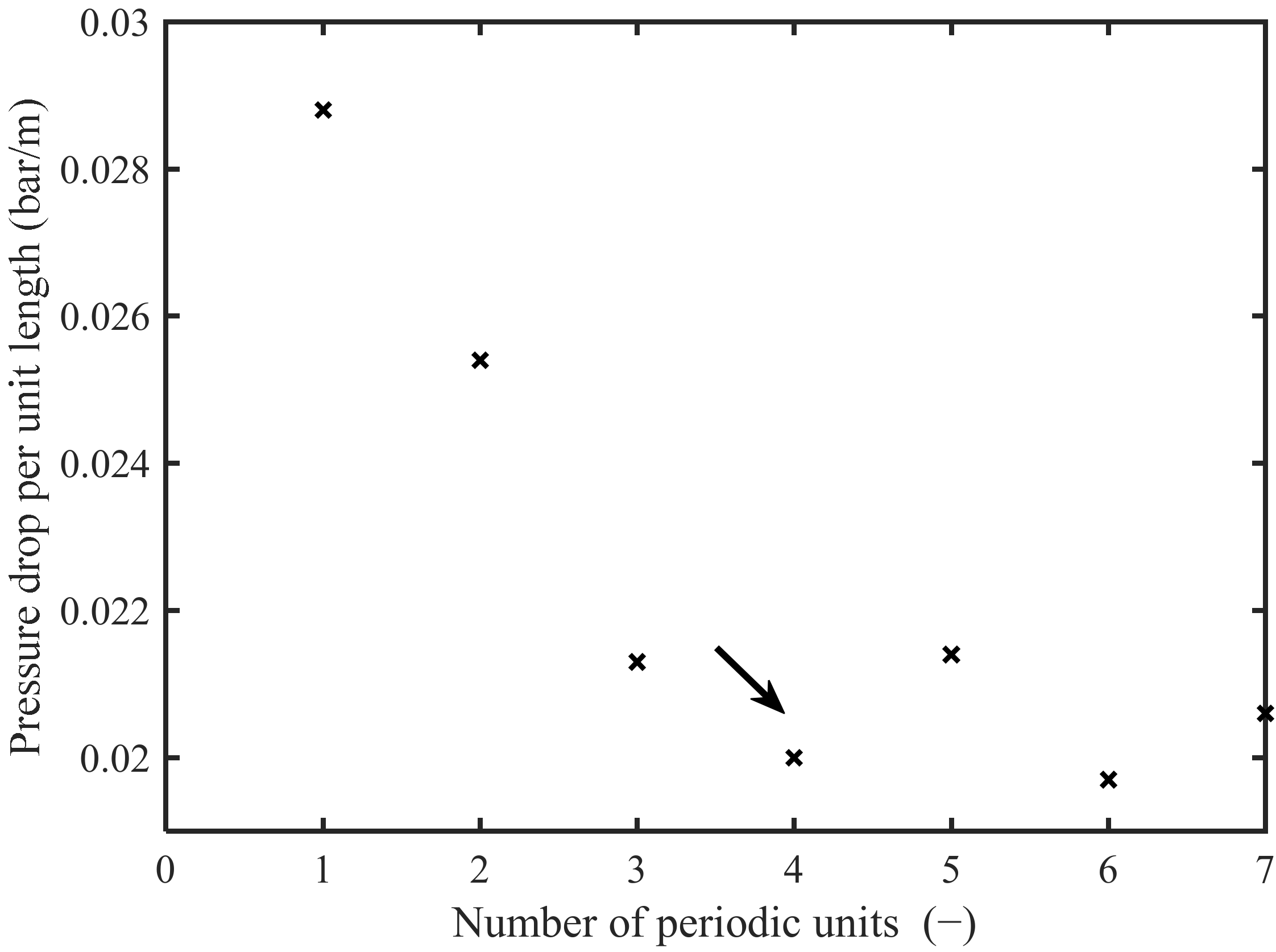
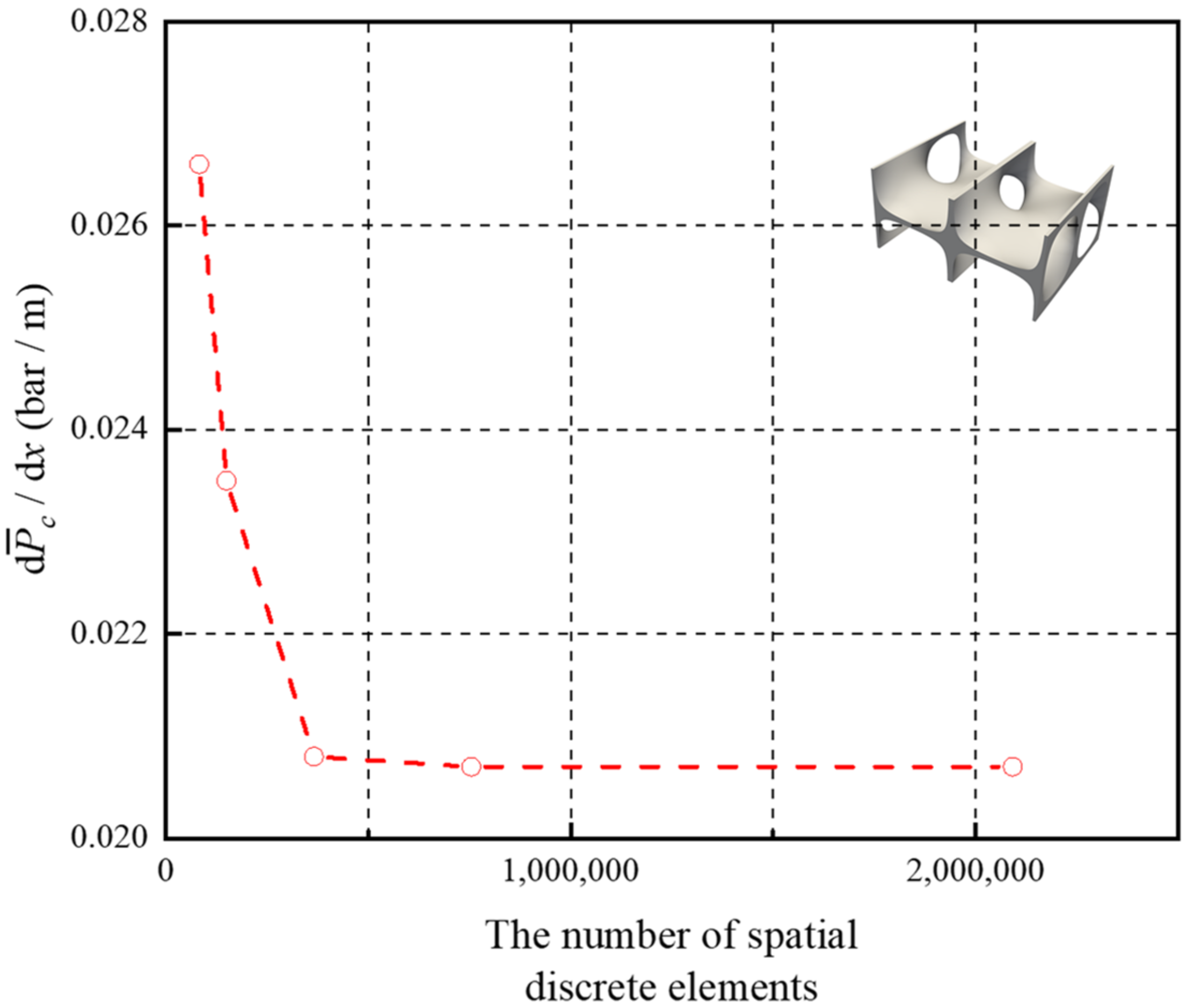

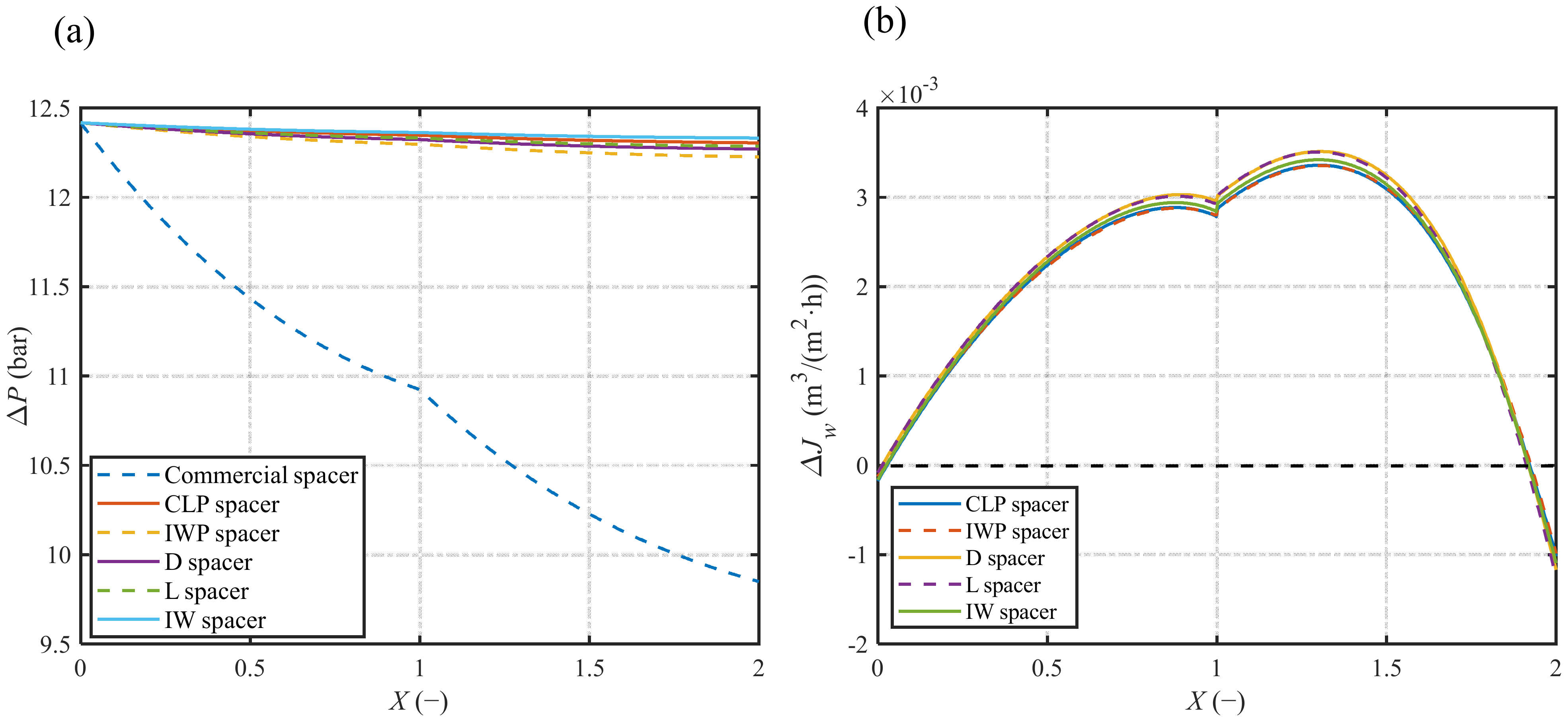
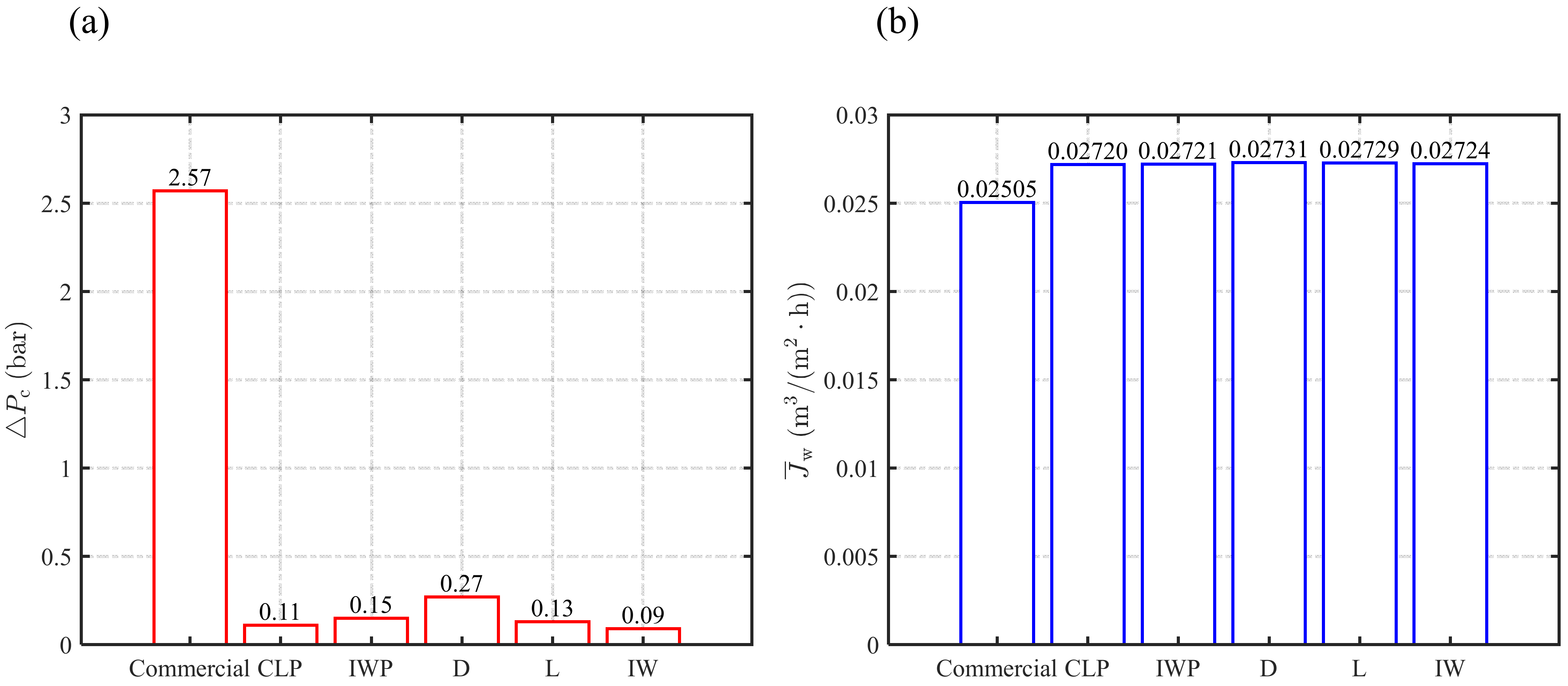
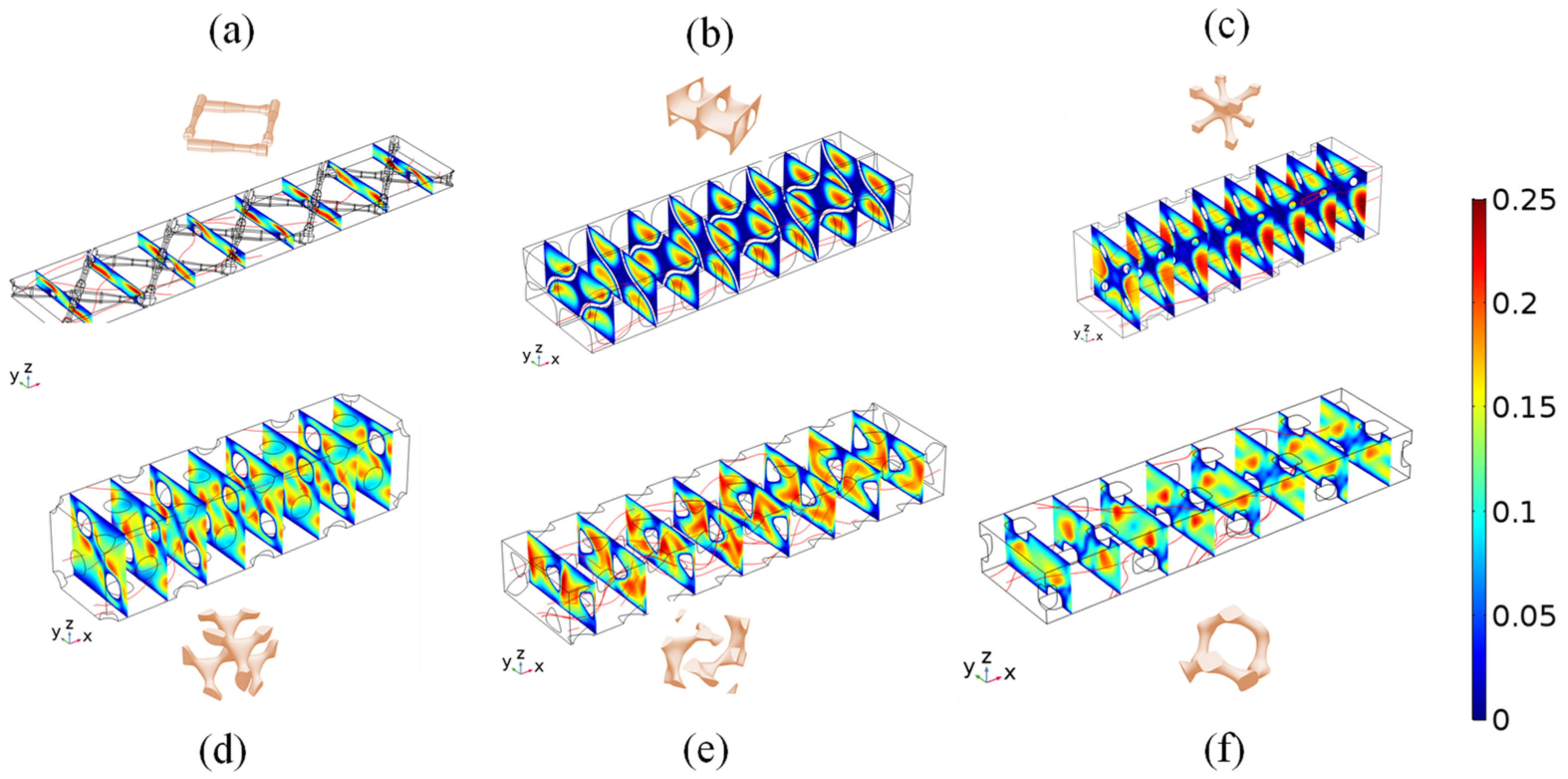
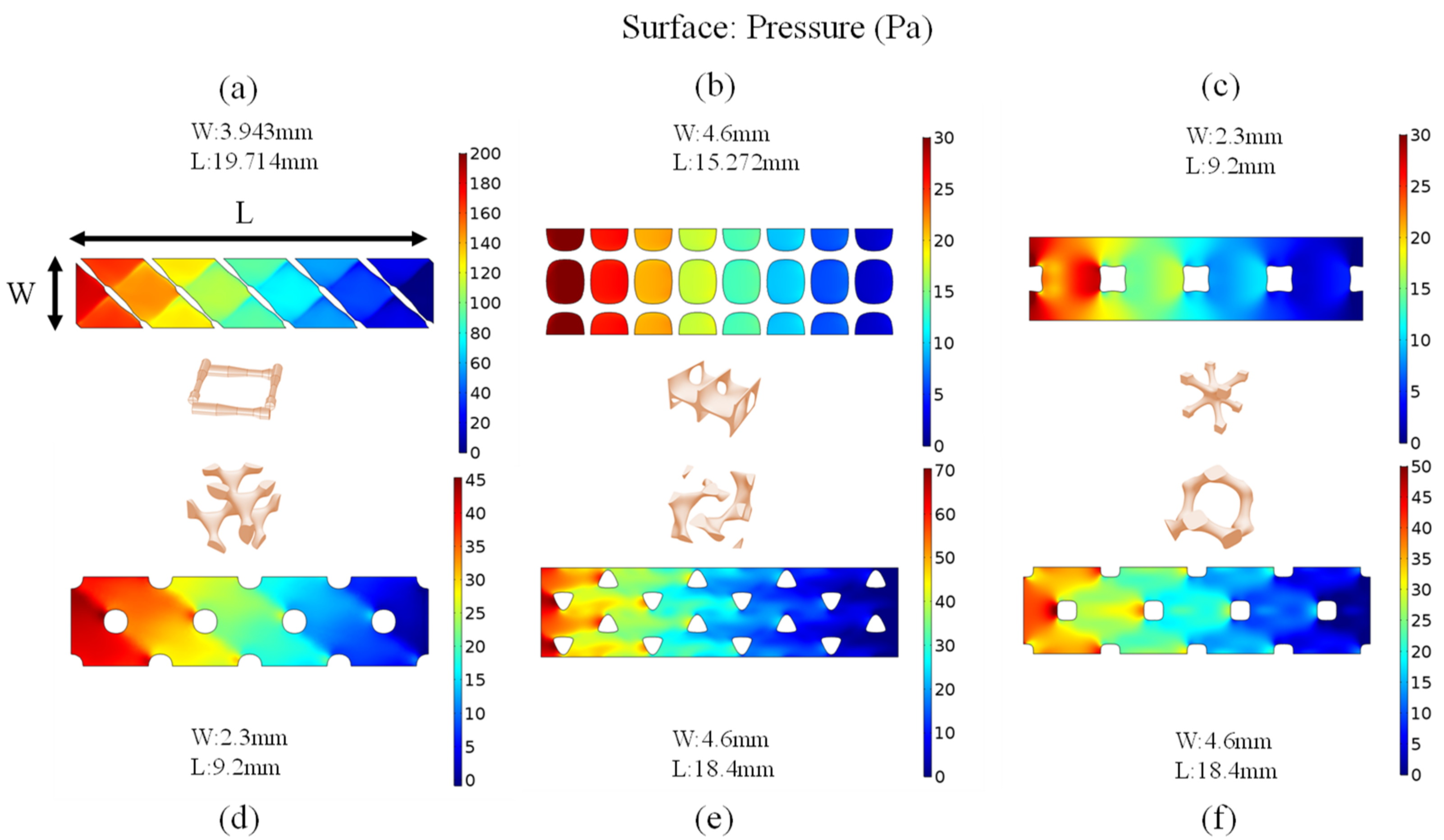
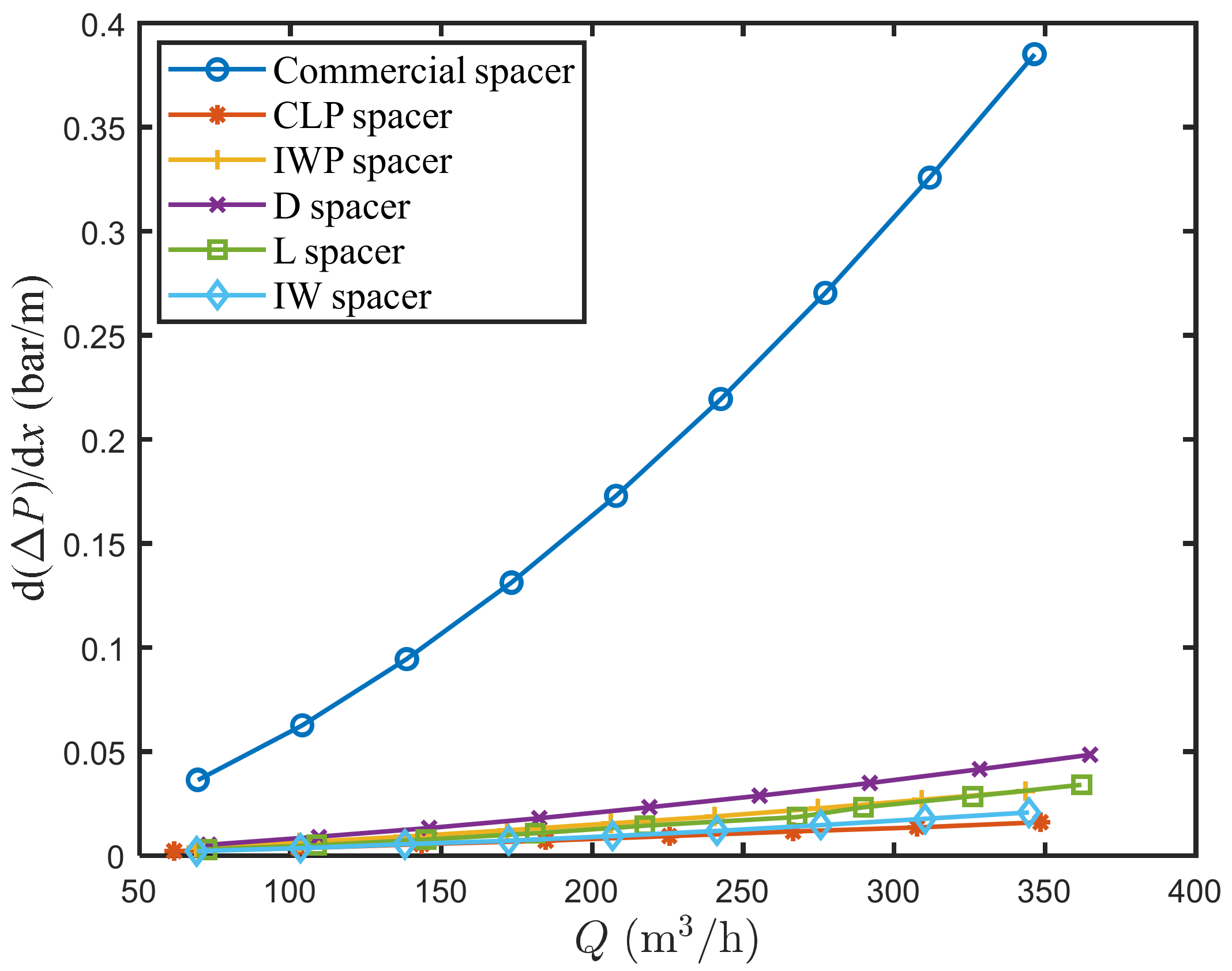
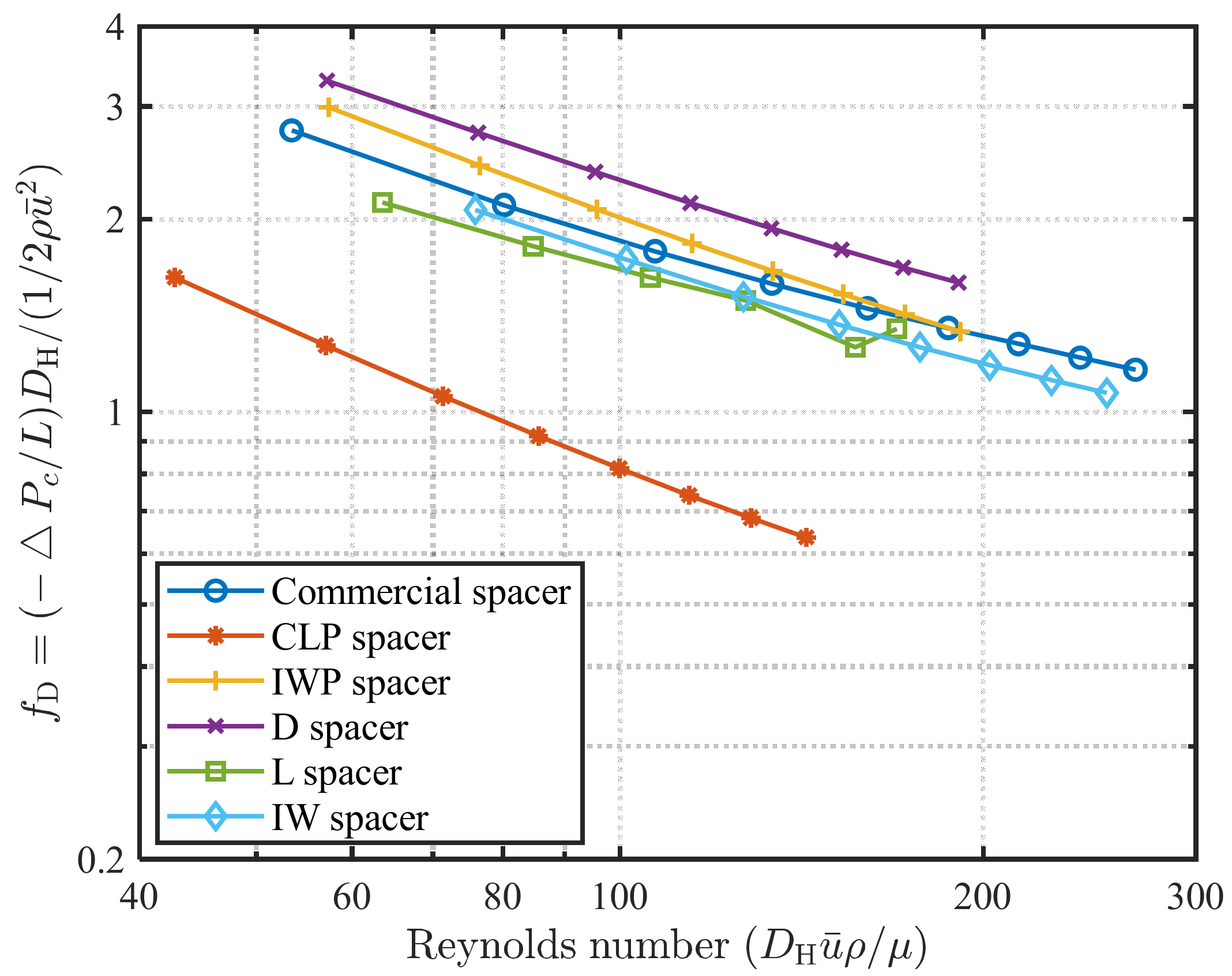
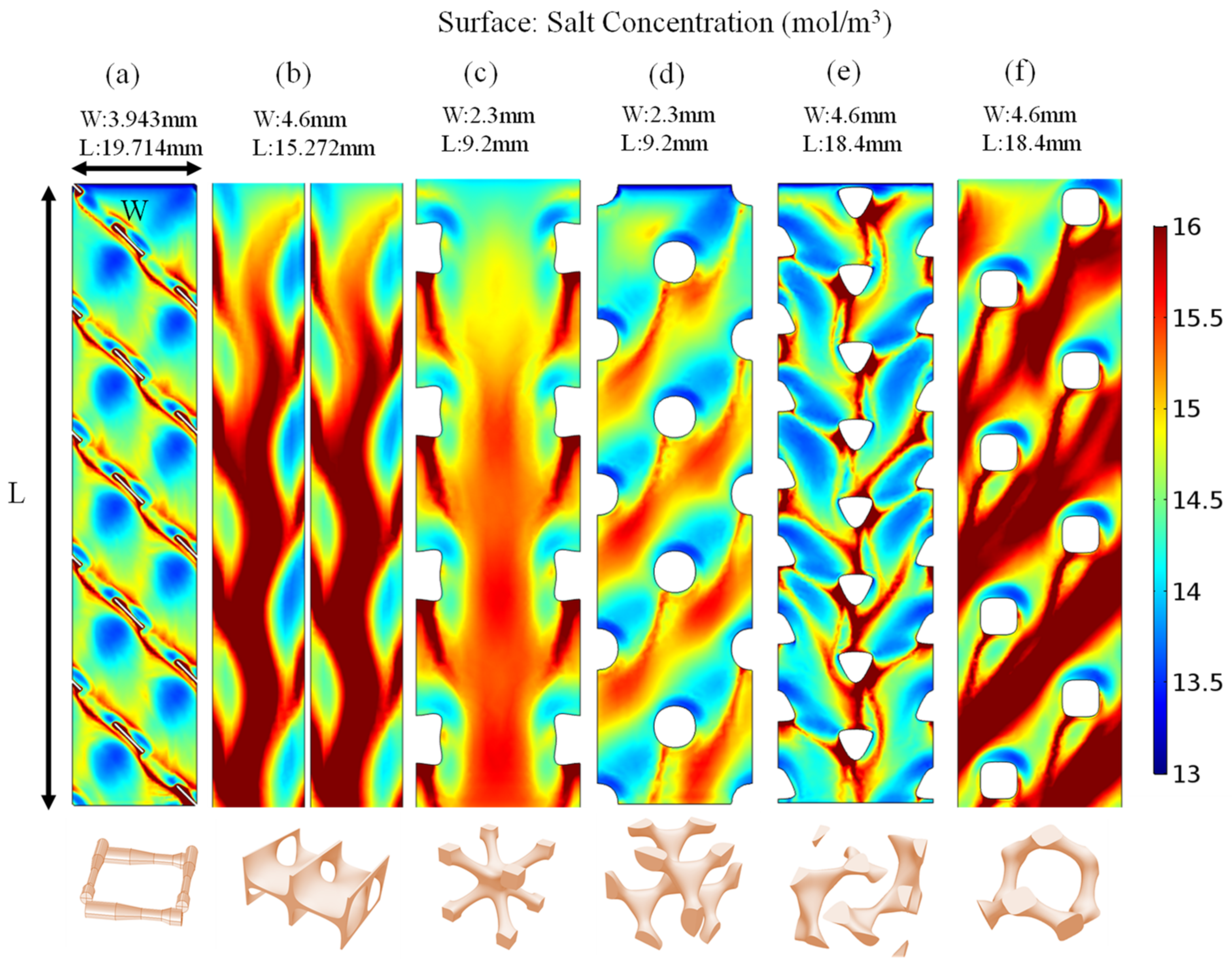
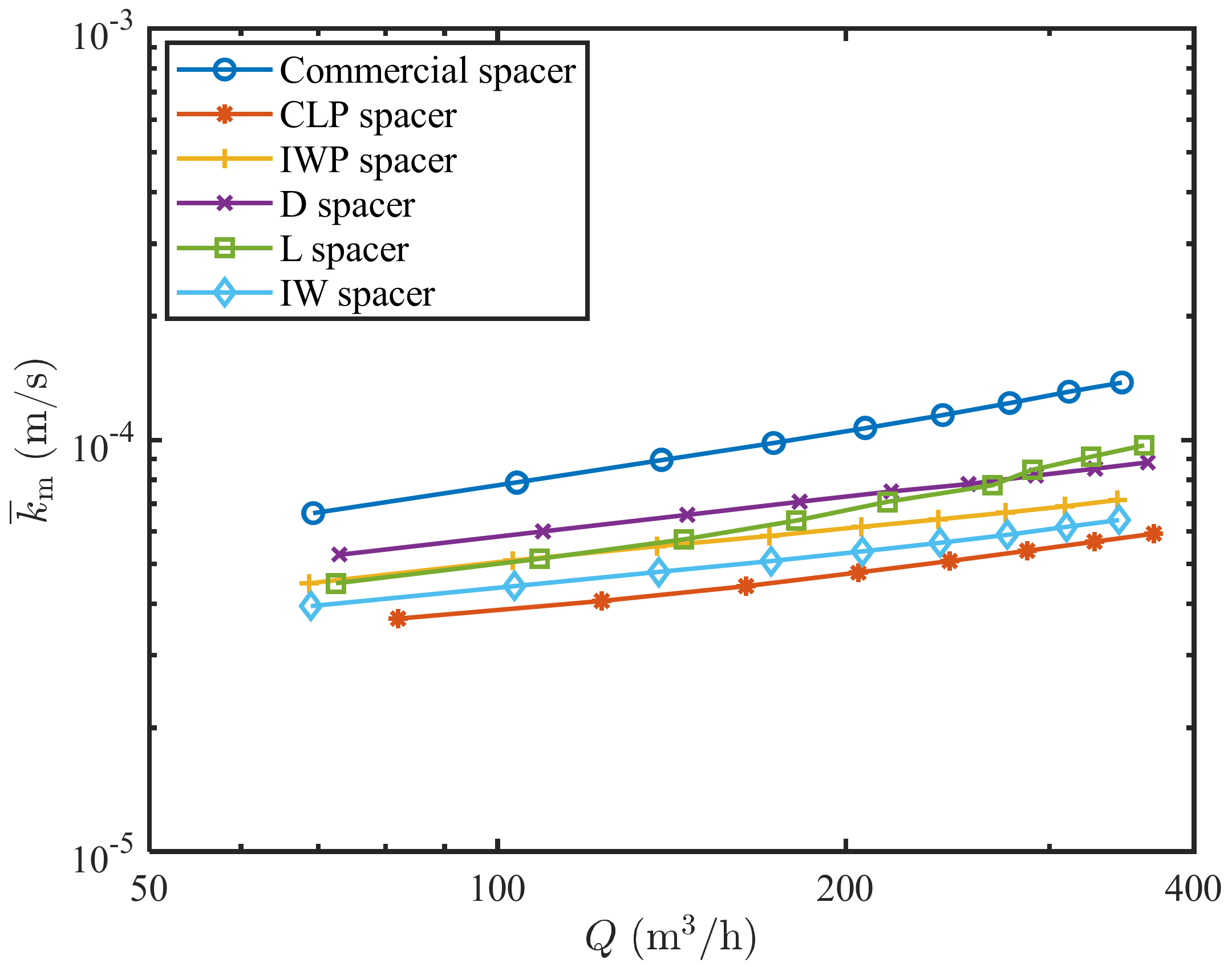
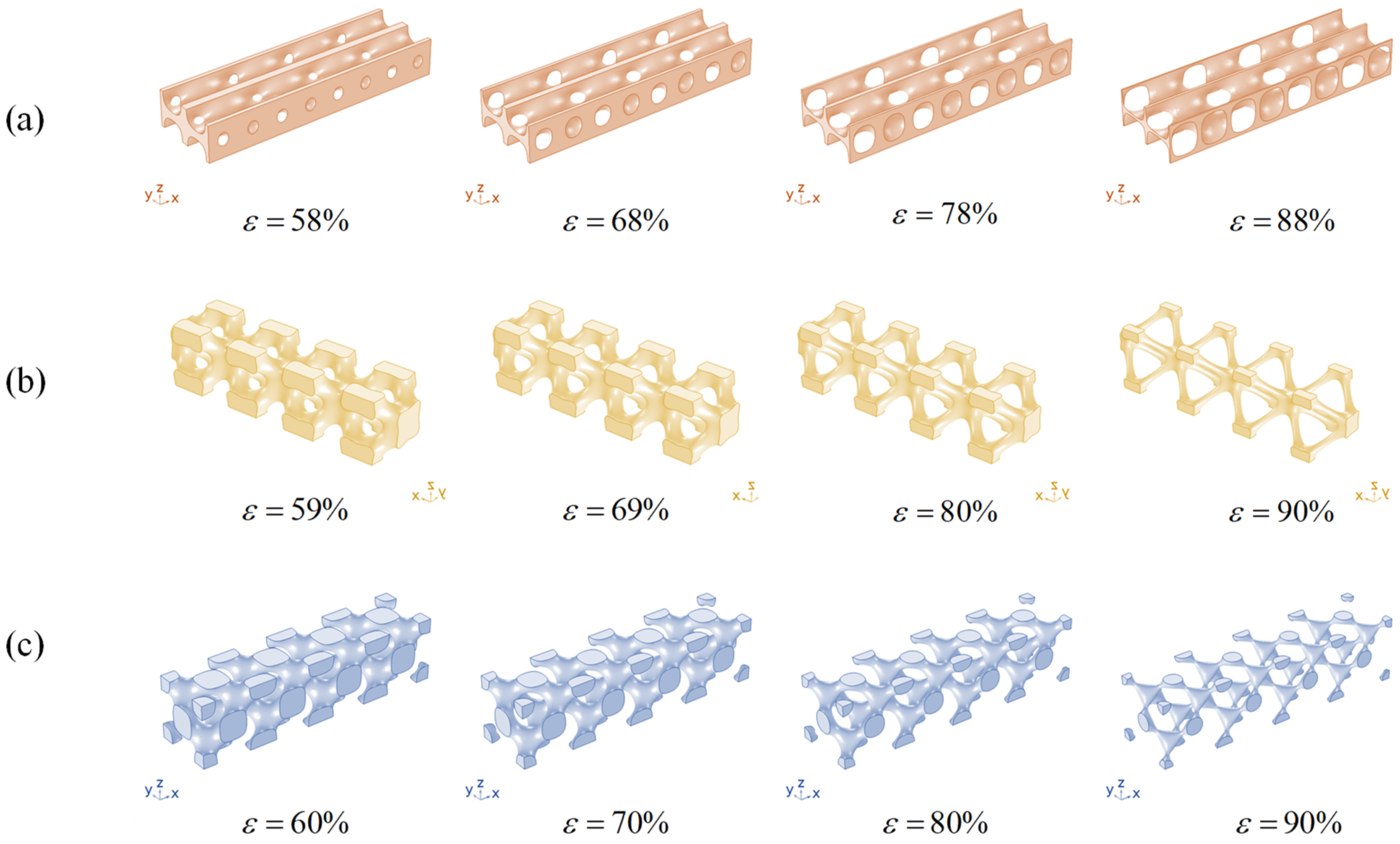
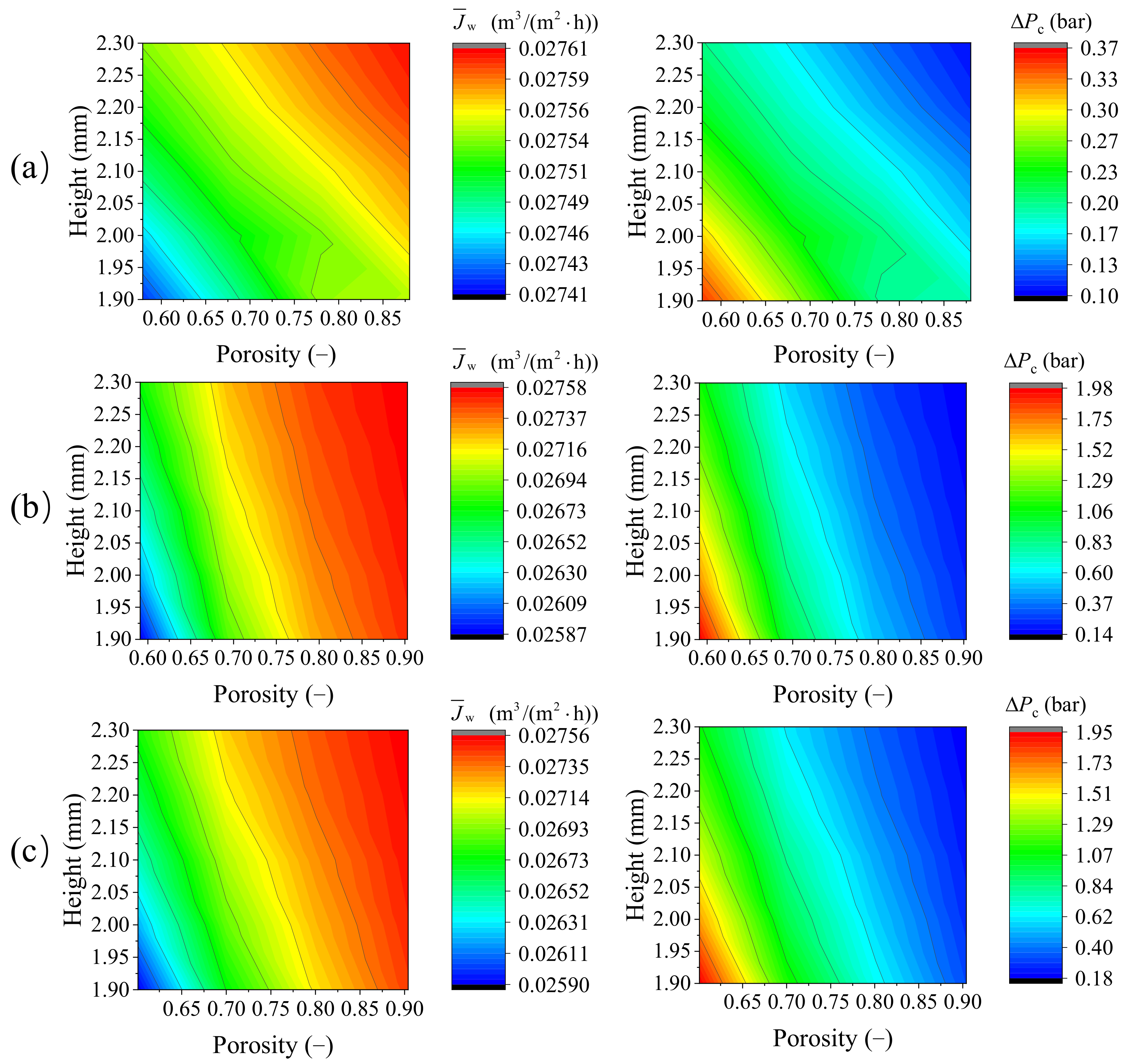
| The Type of Spacer | ||
|---|---|---|
| CLP | 0.88 | 1.37 |
| IWP | 0.90 | 1.79 |
| D | 0.89 | 1.68 |
| L | 0.87 | 1.88 |
| IW | 0.90 | 2.36 |
| Commercial (thickness of 28 mil) | 0.90 | 0.95 |
| Parameters | Commercial | CLP | IWP | D | L | IW |
|---|---|---|---|---|---|---|
| Length, L (m) × 103 | 19.714 | 15.272 | 9.2 | 9.2 | 18.4 | 18.4 |
| Width, W (m) × 103 | 3.943 | 4.6 | 2.3 | 2.3 | 4.6 | 4.6 |
| Height, H (m) × 103 | 0.701 | 2.3 | 2.3 | 2.3 | 2.3 | 2.3 |
| Unit length, l (m) × 103 | 3.943 | 3.818 | 2.3 | 2.3 | 4.6 | 4.6 |
| The Type of Spacer | fD | R2 |
|---|---|---|
| Commercial | 29.93 Re −0.53 | 0.998 |
| CLP | 41.90 Re −0.86 | 0.998 |
| IWP | 44.17 Re −0.67 | 0.999 |
| D | 37.74 Re −0.61 | 0.999 |
| L | 12.83 Re −0.441 | 0.963 |
| IW | 21.72 Re −0.55 | 0.997 |
| The Type of Spacer | R2 | |
|---|---|---|
| Commercial | 0.998 | |
| CLP | 0.986 | |
| IWP | 0.997 | |
| D | 0.997 | |
| L | 0.972 | |
| IW | 0.998 |
| Height (m) × 103 | CLP | 1.9 2.0 2.1 2.2 2.3 |
| IWP | 1.9 2.0 2.1 2.2 2.3 | |
| D | 1.9 2.0 2.1 2.2 2.3 | |
| Porosity (-) | CLP | 0.58 0.68 0.78 0.88 |
| IWP | 0.59 0.69 0.80 0.90 | |
| D | 0.60 0.70 0.80 0.90 |
Publisher’s Note: MDPI stays neutral with regard to jurisdictional claims in published maps and institutional affiliations. |
© 2022 by the authors. Licensee MDPI, Basel, Switzerland. This article is an open access article distributed under the terms and conditions of the Creative Commons Attribution (CC BY) license (https://creativecommons.org/licenses/by/4.0/).
Share and Cite
Chen, Q.; Luo, J.; Heng, Y. High-Throughput Optimal Design of Spacers Using Triply Periodic Minimal Surfaces in BWRO. Separations 2022, 9, 62. https://doi.org/10.3390/separations9030062
Chen Q, Luo J, Heng Y. High-Throughput Optimal Design of Spacers Using Triply Periodic Minimal Surfaces in BWRO. Separations. 2022; 9(3):62. https://doi.org/10.3390/separations9030062
Chicago/Turabian StyleChen, Qiang, Jiu Luo, and Yi Heng. 2022. "High-Throughput Optimal Design of Spacers Using Triply Periodic Minimal Surfaces in BWRO" Separations 9, no. 3: 62. https://doi.org/10.3390/separations9030062
APA StyleChen, Q., Luo, J., & Heng, Y. (2022). High-Throughput Optimal Design of Spacers Using Triply Periodic Minimal Surfaces in BWRO. Separations, 9(3), 62. https://doi.org/10.3390/separations9030062






